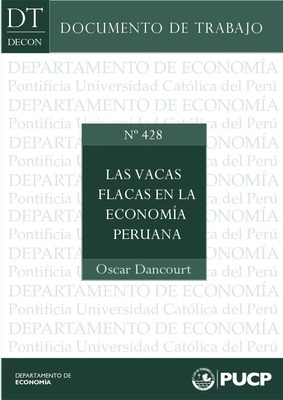| dc.description.abstract | La tasa de crecimiento del PBI no primario cayó a un 3.6% en 2014 y a un 2.4% en 2015, cifras muy por debajo del 7.3% promedio anual registrado durante la década previa; para 2016, se proyecta que la economía urbana tendrá un crecimiento igualmente bajo del 2.8% anual. En la historia macroeconómica del Perú, las épocas de vacas gordas, es decir, los auges más o menos prolongados, son también épocas de precios altos de las materias primas que exportamos; y las épocas de vacas flacas, es decir, las recesiones más o menos intensas donde decrece la actividad económica, son épocas de precios bajos de estas materias primas. Este texto describe el choque externo adverso sufrido por la economía peruana y su impacto recesivo e inflacionario durante 2014-15; analiza las políticas monetarias y fiscales aplicadas en respuesta al choque externo, y concluye listando los retos macroeconómicos del nuevo gobierno de Pedro Pablo Kuczynski.
The growth rate of “non-primary GDP” (Peru´s urban economy) dropped to 3.6% in 2014 and to 2.4% in 2015, far below the annual average of 7.3% recorded over the previous decade; moreover, an equally low growth rate of 2.8% per year is projected in 2016. In the macroeconomic history of Peru, the times of plenty —that is, the more or less prolonged booms— are also times of high prices of the commodities that the country exports; meanwhile, the lean times —that is, the more or less intense recessions in which economic activity slows down— are times of low commodity prices. This article describes the negative external shock undergone by the Peruvian economy and its recessionary and inflationary effects over 2014-15; analyzes the fiscal and monetary policies applied in response to the external shock, and concludes by outlining the macroeconomic challenges faced by the new government of Pedro Pablo Kuczynski. | en_US |


